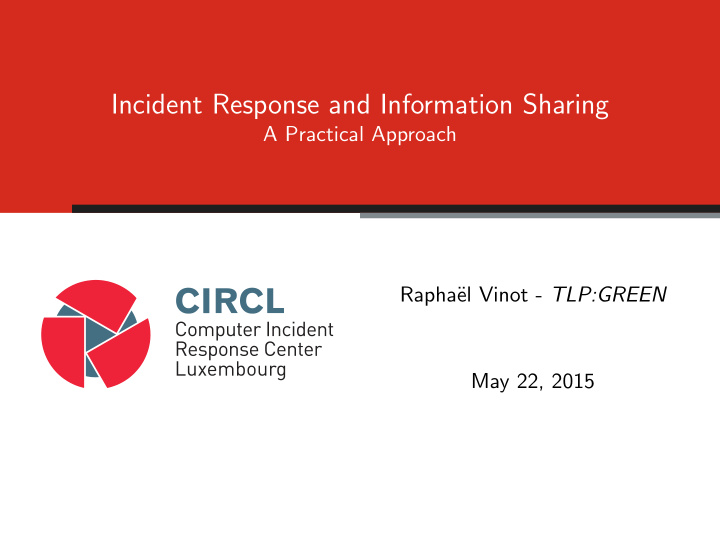



Incident Response and Information Sharing A Practical Approach Rapha¨ el Vinot - TLP:GREEN May 22, 2015
• The Computer Incident Response Center Luxembourg (CIRCL) is a government-driven initiative designed to provide a systematic response facility to computer security threats and incidents. • CIRCL is the CERT for the private sector , communes and non-governmental entities in Luxembourg. 2 of 13
CIRCL Services • Incident ticket creation for reported ICT incidents via different media (e.g. international CSIRT channels, national incident reports,...) • Incident identification and triage • Technical investigation including information correlation (e.g. security vulnerability/incidents matching, similar incident resolution, malware reversing, system and network forensic...) • Incident coordination might also include vulnerability handling , responsible vulnerability disclosure (e.g. the software originating the incident) or incident response training • Services availability to organizations/citizen incorporated in Luxembourg 3 of 13
Sharing indicators • In order to improve sharing of Indicators of Compromise (IOCs), MISP was introduced in 2013: • Sharing indicators about targeted attacks. • Improve detection time of unknown malware. • Avoid reversing similar malware (focusing on new analysis). 4 of 13
MISP overview 5 of 13
MISP technical overview 6 of 13
What kind of attributes are shared in MISP? • Hashes of malware (MD5, SHA1, SHA256). • IP addresses, ASN numbers. • Hostnames and domain names. • patterns in file, disk or memory. • named pipes, mutexes • Malware family • Vulnerability related (CVE Numbers) • These indicators can be used to search for potential compromised systems in network logs (proxy, firewall), system log. 7 of 13
What are other benefits? • Attackers and adversaries can be lazy. They reuse infrastructures and techniques. • You can find relationships between the attackers’ campaigns and the indicators. 8 of 13
Sharing indicators not detected by AntiViruses • Indicators are often shared before they are detected by A/V. • Dridex malware sample in April 2015: AV Detection Time 28e846a8874aad9a4bc4c10286feab7b 50 29ea22b9b5c142b52457881c8c314735 56c9bf2743144817170920ca122ed0fb Number of detections 40 30 20 10 0 0 5 10 15 20 Number of days 9 of 13
Statistics • 145732 attributes in MISP for private sector. • 27920 correlated attributes (at least shared between two events). • 117 international companies and organizations are on the MISP platform. 10 of 13
Future • Pseudonimity • STIX Import • TAXII for sharing between instances • Improvements in the API • Request Policy Zone Configuration export • VirusTotal integration • SMIME • New attributes • What else do *you* need? • For bugs or features requests: https://github.com/MISP/MISP/issues 11 of 13
Conclusion • Fetching indicators from MISP and searching internally is already a quick win. • Contributing is not required but it’s enhancing the global view on who already seen/worked on such attack. • Small incidents can be the origin of ”complex targeted attacks”. • All the CERTs can request an access to the platform • Sharing of indicators can be also done anonymously via CIRCL if required. 12 of 13
Contact • info@circl.lu • https://www.circl.lu/ • OpenPGP fingerprint: 3B12 DCC2 82FA 2931 2F5B 709A 09E2 CD49 44E6 CBCD 13 of 13
Recommend
More recommend